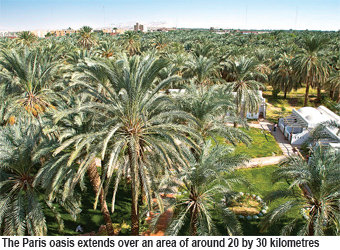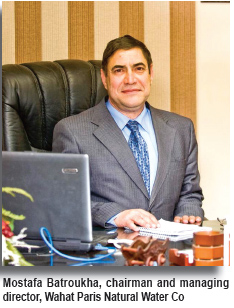 Wahat Paris Natural Water, a newly founded Egyptian water company, is bottling water in the middle of the Saharan desert
Wahat Paris Natural Water, a newly founded Egyptian water company, is bottling water in the middle of the Saharan desertMINERAL water from the desert or, to be absolutely precise - from an oasis - that's the concept behind the newly founded Egyptian water company Wahat Paris Natural Water Co. The young enterprise enjoys potent backing: the Egyptian Ministry of Petroleum the authority responsible for exploration, production, processing and distribution of oil and gas in Egypt, and, definitely one of the biggest employers in the North African desert nation. So the sales of "Aqua Paris", named after the eponymous oasis in the south west of Egypt, would appear safe enough for now. Egypt is about three times as large as Germany, so you would think that there's plenty of room for residential areas and farming. The reality is quite the opposite, however, because approximately 80 million inhabitants live within only about five per cent of the land called the "green areas". This means that the number of people per habitable unit area, the population density, is many times higher than in Germany, a problem the Egyptian Government is exerting efforts to overcome by promoting remote areas such as the Oasis.
 Gift from the Nile Egypt is a gift from the Nile. Over millennia, thanks to regular annually recurring floods in Africa's longest river, an extremely fertile strip of land up to 60 kilometres wide spreads out from both banks of the Nile, in which human life could flourish and prosper. For almost three millennia, from 3200 BCE to 340 BCE, dynasties of Pharaohs developed one of mankind's greatest civilisations, also protected by their largely isolated location, with the Libyan Desert in the west, and the Arabian Desert in the east. It was only when the High Dam in Aswan was completed in 1971 on the upper reaches of the Nile, thus creating Lake Nasser, that the floods on the river's lower reaches ceased. Besides the actual course of the river, the very extensive Nile Delta constitutes the second major area of settlement for the Egyptians. Other habitable regions, in addition to the coasts of the Red Sea and the Mediterranean, include the oases in the desert of the "New Valley". "El Wadi el Gedid", to give it its Arabic name, lies between the Nile and Libya, in the southwest of the country, and accounts for more than 40 per cent of Egypt's total area. Under this valley, flows a gigantic underground aquifer, which receives its water from Central Africa and Lake Nasser, and in its turn supplies the oases. The Egyptian government has plans for using artificial irrigation from Lake Nasser to supply an additional 200,000 hectares of farmland and create new settlement areas for millions of inhabitants. Desert and Oases Humans have found a way to co-exist with nature here ever since the Stone Age. Whilst people have lived in this desert valley for hundreds of centuries, the New Valley remains thinly populated despite its size. For the time being, the area continues to be a landscape dominated by desert - and oases. But the weather-beaten rock formations and the gigantic dunes are beyond the reach of the human calendar. The oases are simply depressions in the desert in which springs or wells have been created fascinating landscapes with abundant, plant life, flourishing trees and lakes, and vibrant human culture. Embedded too in the desert landscape are green valleys with high hills, there are many villages and small towns. In these oases, you will find desert areas next to greenery around the wells. In many cases, the springs are of such high quality in terms of mineral content that they are even suitable for medicinal cures. There are cold springs bubbling up from underground, and hot sulphurous-water springs, wonderfully well suited for treating rheumatism, stomach complaints, colds and allergies. TNike Schuhe
Gift from the Nile Egypt is a gift from the Nile. Over millennia, thanks to regular annually recurring floods in Africa's longest river, an extremely fertile strip of land up to 60 kilometres wide spreads out from both banks of the Nile, in which human life could flourish and prosper. For almost three millennia, from 3200 BCE to 340 BCE, dynasties of Pharaohs developed one of mankind's greatest civilisations, also protected by their largely isolated location, with the Libyan Desert in the west, and the Arabian Desert in the east. It was only when the High Dam in Aswan was completed in 1971 on the upper reaches of the Nile, thus creating Lake Nasser, that the floods on the river's lower reaches ceased. Besides the actual course of the river, the very extensive Nile Delta constitutes the second major area of settlement for the Egyptians. Other habitable regions, in addition to the coasts of the Red Sea and the Mediterranean, include the oases in the desert of the "New Valley". "El Wadi el Gedid", to give it its Arabic name, lies between the Nile and Libya, in the southwest of the country, and accounts for more than 40 per cent of Egypt's total area. Under this valley, flows a gigantic underground aquifer, which receives its water from Central Africa and Lake Nasser, and in its turn supplies the oases. The Egyptian government has plans for using artificial irrigation from Lake Nasser to supply an additional 200,000 hectares of farmland and create new settlement areas for millions of inhabitants. Desert and Oases Humans have found a way to co-exist with nature here ever since the Stone Age. Whilst people have lived in this desert valley for hundreds of centuries, the New Valley remains thinly populated despite its size. For the time being, the area continues to be a landscape dominated by desert - and oases. But the weather-beaten rock formations and the gigantic dunes are beyond the reach of the human calendar. The oases are simply depressions in the desert in which springs or wells have been created fascinating landscapes with abundant, plant life, flourishing trees and lakes, and vibrant human culture. Embedded too in the desert landscape are green valleys with high hills, there are many villages and small towns. In these oases, you will find desert areas next to greenery around the wells. In many cases, the springs are of such high quality in terms of mineral content that they are even suitable for medicinal cures. There are cold springs bubbling up from underground, and hot sulphurous-water springs, wonderfully well suited for treating rheumatism, stomach complaints, colds and allergies. TNike Schuhe
 iConnectHub
iConnectHub
 Login/Register
Login/Register Supplier Login
Supplier Login


























